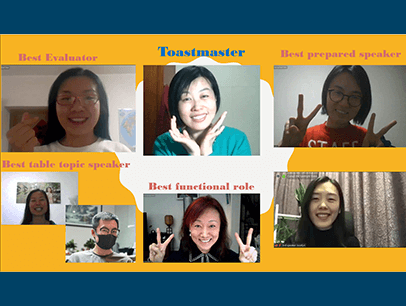
People presenting at work strive to display executive presence in many situations, including speaking on a phone call, in a meeting, or at a lectern at a conference or gala. When you present virtually, there are more nuances to showing executive presence—a manner that reflects poise and professionalism, confidence, and capability.
During this time of COVID-19, when virtual meetings and online conferences have become the norm rather than the exception, those nuances are worth exploring. They can help you thrive as you focus on the five key elements of executive presence: stance, sound, smile, silence, and sight.
Stance
To convey confidence when speaking, open your posture and move purposefully. If you are delivering a speech virtually or leading a webinar, position your computer so you can stand up to deliver your remarks—keeping the camera at eye level—just as you would for an in-person speech. Standing increases your energy level and serves as a constant reminder that you are in public-speaking mode, even if you can’t see your audience.
For meetings and conversations conducted by video conference, sit tall in a structured office or dining chair (rather than a cushy couch or chair that can compromise posture).
For good news, neutral information, or technical topics, throw on a smile.
Use gestures to reinforce what you are saying and remember to avoid nervous movements (clicking pens, swaying, twisting in a chair, twirling hair) that are distracting. When you do use purposeful movements, make sure they are in the frame of your camera (viewers should see more than your head—chest up and a little wider than your shoulders is ideal). Avoid gesturing toward the camera; this distorts the size of your hands and looks awkward.
Sound
If you want to sound confident, your voice must be easily audible. This starts with excellent posture (hence, standing or sitting in a firm chair) and requires full breaths between sentences (as sound comes from the movement of air over the vocal cords). Aim to speak in the low end of your natural range, at a slow rate, and crisply; all are best practices but particularly useful in computer-mediated formats that have been developed and optimized for lower vocal tones and which have the propensity to distort and freeze.
If you spend lots of time participating in video conferences or if you facilitate meetings or webinars, you should invest in a high-quality microphone.
Smile
Even serious professionals talking about serious topics look more assured when they have a “bright” face—a slight lift of the eyes, cheeks, and corners of the mouth. A soft smile not only makes your voice more pleasant to listen to, it disguises any nervousness you may be experiencing and makes you appear friendly, approachable, and enthusiastic.
You want to use other facial expressions when delivering bad news so there is never a conflict between your verbal and nonverbal communication. But for good news, neutral information, or technical topics, throw on a smile. And remember, in virtual meetings everyone can see your face in the attendee gallery even when you aren’t speaking! So maintain that soft smile when you are listening too.
Silence
When speakers avoid pauses, it often results in sentences that are littered with filler words, such as “um,” “ah,” “you know,” “kind of,” “like,” “so,” and “well.” Used in excess, they can be distracting and undermine your credibility. Instead of defaulting to such verbal crutches, employ well-placed pauses—offering the sound of silence—to elevate your speech or presentation.
Virtual presenters are particularly at risk for filler words. Without the visual feedback of your listeners’ faces, an unprepared webinar facilitator or virtual speaker is more likely to develop “inner chatter” and nervousness, which often manifests in filler words. Unlike live keynote speakers or trainers, however, virtual presenters do have to be careful not to make their pauses too long; otherwise, audience members might get confused by the silence.
With long pauses in meetings, listeners might miss nonverbal cues that you intend to continue speaking and could cut you off. To prevent interruptions, prepare key points in advance and enumerate them (“there are three reasons why I support this recommendation”). If someone does interrupt, you can more easily regain the floor (“I promised three reasons, let me share the third before we move on”).
Sight
Lasting eye contact is crucial for building rapport with listeners and conveying confidence as a speaker. It’s also particularly difficult in virtual presentations because you need to position your equipment properly and stare at a tiny colored dot on your computer or an external camera lens to give virtual listeners the experience of receiving eye contact.
If your laptop is on a desk or your lap, you will be looking down at the camera.
So, first position your camera at eye level. If your laptop is on a desk or your lap, you will be looking down at the camera. Set it on a few thick books or on a sturdy box on a table or desk to get it to your eye level. If you have a desktop computer, the camera may be too high, so you may need to lower it or raise your chair to achieve eye level.
Admittedly, it is hard to hold your gaze with a piece of camera equipment. To make it easier, you can arrange the gallery of virtual listeners on your computer screen right below your camera lens so you can look at images of audience members closer to your camera. You can also tape a small picture of a loved one or a toy figurine right above or next to your camera lens to remind you to look at the camera to give your virtual listeners the appearance of eye contact.
By understanding the five elements of executive presence—stance, sound, smile, silence, sight—as well as their nuances, you will be able to convey confidence and stand out for the right reasons in any online workplace speaking situation.
Christine Clapp, DTM is the founder and president of Spoken with Authority, a presentation skills consultancy that elevates the presence and expands the influence of subject-matter experts, leaders, and emerging leaders. She is the co-author of three books, most recently Presenting Now: A Guide to Public Speaking and Leadership Communication Online, in Person, and Beyond.
Related Articles

Online Meetings
Optimize the Performance of Your Video Conferences

Online Meetings



 Previous
Previous
 Previous Article
Previous Article